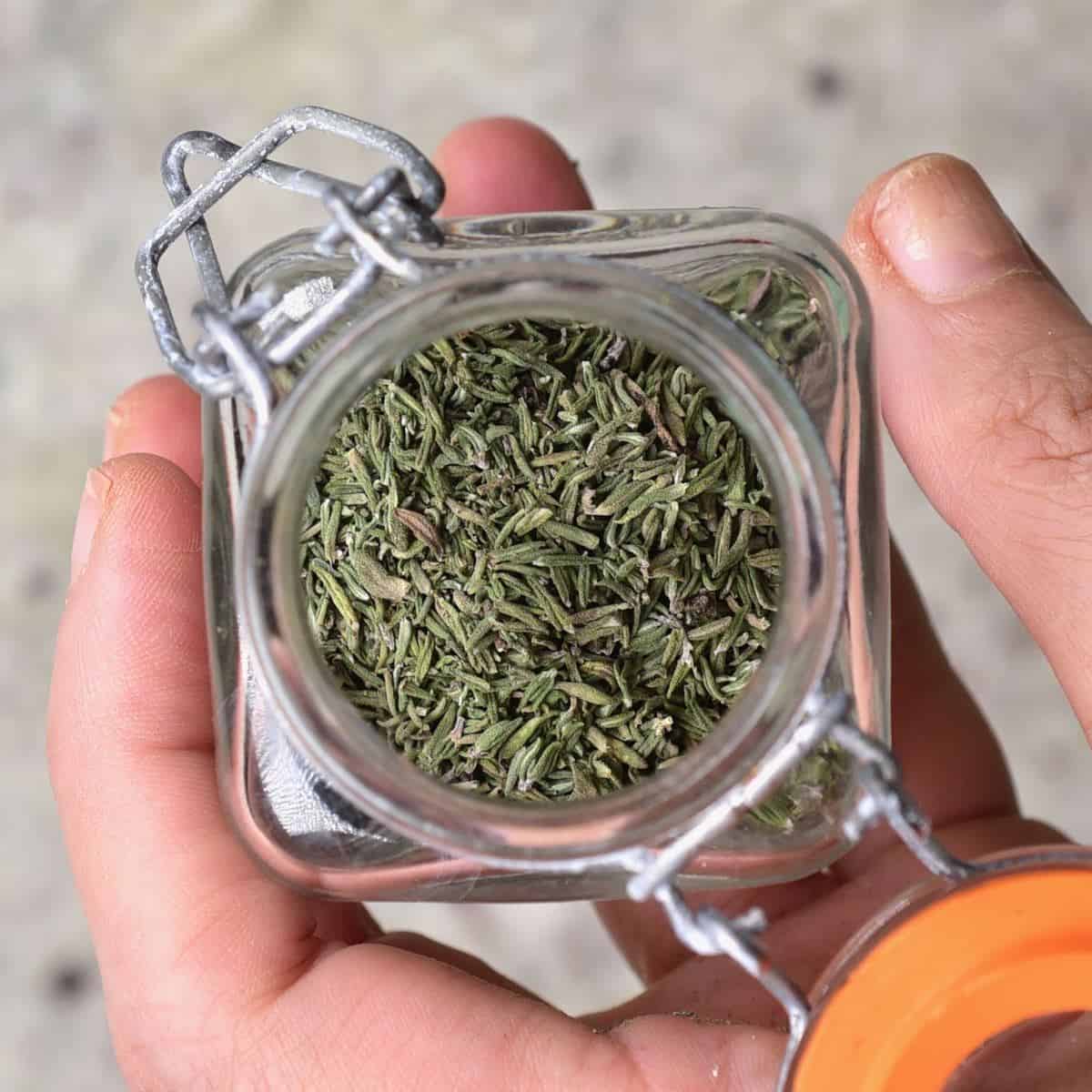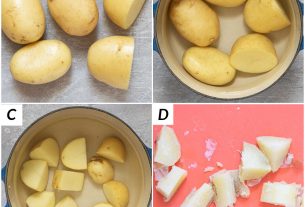Thyme, with its aromatic leaves and earthy flavor, can elevate any dish to a whole new level.
But what happens when this culinary staple is no longer in season?
Fear not, for we have the solution.
In this article, we unravel the secrets of drying thyme at home, ensuring you never have to bid farewell to this tantalizing herb again.
So, gather your bundles and let’s embark on a journey of preserving thyme’s essence, one leaf at a time.
how to dry thyme
To dry thyme, there are two methods you can use: air drying and oven drying.
For air drying, bundle the thyme and hang it in a cool, dry place with airflow for approximately 2 weeks.
Check the thyme daily, and when it crumbles between your fingers, remove the leaves from the stems and store them in a glass jar.
To oven dry, spread the thyme on a parchment-lined baking sheet and set the oven to the lowest temperature.
Leave the oven door slightly ajar and check the thyme every 15 minutes until it crumbles, which should take about 1 hour.
Remove the leaves from the stems and store them in a glass jar.
Label the jar with the herb and date of drying and store in a cool, dry place for up to a year.
Key Points:
- There are two methods to dry thyme: air drying and oven drying.
- For air drying, bundle the thyme and hang it in a cool, dry place with airflow for 2 weeks.
- Check the thyme daily and remove leaves from stems when it crumbles.
- For oven drying, spread thyme on a parchment-lined baking sheet and set the oven to the lowest temperature.
- Leave the oven door slightly ajar and check the thyme every 15 minutes until it crumbles, which typically takes 1 hour.
- Label the jar with the herb and date of drying, and store in a cool, dry place for up to a year.
how to dry thyme – Watch Video
💡
Pro Tips:
1. Thyme should be dried before using in recipes to enhance its flavor and aroma.
2. Did you know? Thyme is actually a member of the mint family, which explains its refreshing scent and taste.
3. The best time to harvest thyme for drying is in the morning, after the dew has dried but before the heat of the day sets in.
4. Hanging bundles of thyme upside down in a warm, well-ventilated area is one of the oldest and most effective methods of drying thyme.
5. If you’re short on time, you can also dry thyme in the microwave! Simply place the leaves on a microwave-safe plate and heat for short intervals until dry, being careful to avoid overheating and burning the herb.
Introduction: How To Dry Thyme At Home For Use In Recipes
Thyme is an aromatic herb commonly used in various culinary dishes. However, as a perennial plant, thyme tends to die in colder climates, making it challenging to have access to fresh thyme all year round. That is why learning how to dry thyme at home can be immensely beneficial. By drying thyme, you can:
- Ensure year-round availability of this versatile herb
- Prevent food waste
- Preserve its potent flavor and nutrients.
Drying thyme at home is a simple process that can be done in a few easy steps:
- Harvest fresh thyme sprigs from your garden or purchase them from a reputable source.
- Gently rinse the sprigs under cold water to remove any dirt or debris.
- Pat the thyme dry with a paper towel to remove excess moisture.
- Bundle the sprigs together and secure them with a string or rubber band.
- Hang the bundles upside down in a well-ventilated area. Make sure the area is dry and away from direct sunlight.
- Allow the thyme to air dry for approximately two to three weeks. The sprigs should become brittle and easily crumble when touched.
- Once dried, remove the leaves from the stems by gently rubbing the sprigs between your fingers. Discard the stems and store the dried thyme leaves in an airtight container.
- Label the container with the date of drying for future reference.
To enjoy the dried thyme, simply add it to your desired recipes, adjusting the quantity based on your taste preferences. Its concentrated flavor will add depth and aroma to soups, stews, roasted vegetables, and marinades.
Drying thyme at home is a practical way to ensure a constant supply of this versatile herb. With its potent flavor and nutrient preservation, your dishes will be enhanced all year round.
Thyme: A Perennial Plant That Dies In Colder Climates
Thyme, scientifically known as Thymus, is a small perennial plant that belongs to the mint family. It is characterized by its tiny leaves, which emit a delightful aroma when crushed or heated. Thyme is native to the Mediterranean region and is popular in Mediterranean and European cuisines.
In colder climates, thyme plants may struggle to survive due to the freezing temperatures. These plants often experience a decline in growth and vitality, ultimately leading to their demise. However, even in regions where thyme thrives year-round, drying thyme is still a valuable practice to enjoy its flavor during the offseason or when fresh thyme is not readily available.
Benefits Of Drying Thyme: Year-Round Access And Food Waste Prevention
Drying thyme has several advantages that extend beyond ensuring a constant supply of this aromatic herb. Firstly, it allows you to preserve the flavors and nutrients of fresh thyme for an extended period. Dried herbs, when properly stored, can last for at least a year, providing you with the same level of taste and nutritional benefits as fresh thyme when needed.
Furthermore, drying thyme is an excellent way to prevent food waste. Many home cooks often purchase fresh herbs in bundles but find themselves unable to use the entire amount before it spoils. By drying thyme, you can avoid wasting the surplus while having a plentiful supply of this essential ingredient at hand whenever required.
Methods Of Drying Herbs: Air Drying And Oven Drying
When it comes to drying thyme or any other herb, there are two primary methods: air drying and oven drying. Both approaches are simple, accessible, and highly effective. The choice between the two methods largely depends on personal preference and the availability of equipment.
Air drying, often regarded as the traditional method, involves hanging thyme bundles in a cool, dry place. This allows the moisture to slowly evaporate from the thyme, resulting in dried leaves that retain their flavor. It is a convenient option for those who don’t have access to an oven or prefer a more hands-off approach. Air drying has the following advantages:
- Simple and traditional method
- Requires minimal equipment
- Allows for natural evaporation of moisture
- Retains the flavor of the thyme
Oven drying, on the other hand, requires the use of an oven set to a low temperature. This method speeds up the drying process by utilizing heat. It is a suitable option for those who prefer a quicker method or need to dry large quantities of thyme. Oven drying has the following advantages:
- Faster drying process
- Ideal for larger quantities of thyme
- Can be easily controlled with temperature settings
- Provides consistent results
Regardless of the method chosen, the end result will be equally flavorful and usable thyme. It is important to note that fresh thyme should be used for drying, as it yields the best flavor and aroma. Additionally, make sure to properly store the dried thyme in airtight containers to maintain its quality.
In conclusion, whether you prefer the traditional air drying method or the quicker oven drying method, both are effective ways to dry thyme and preserve its flavor. Find the method that suits your preferences and enjoy the convenience of having dried thyme readily available for culinary use.
“The art of drying herbs is a culinary tradition that enhances the flavor and aroma of dishes.”
Air Drying Method: Tying And Hanging Thyme Bundle In A Cool, Dry Place
To air dry thyme, you will need:
- Fresh thyme sprigs
- Kitchen twine
- A cool, dry place with proper airflow
Start by gathering several thyme sprigs and tying them together with kitchen twine to form a bundle. Make sure the bundle is secure but not overly tight to allow airflow.
Next, find a suitable location to hang the thyme bundle. Ideally, this place should be:
- Cool
- Dry
- Well-ventilated
Some popular options include a pantry, an unused closet, or an airy kitchen corner away from direct sunlight. Hang the thyme bundle upside down, ensuring that it is not in contact with any surfaces.
Note: It is essential to create the proper environment for air drying thyme to prevent mold or spoilage.
Air Drying Method: Checking Drying Progress And Storing Dried Thyme
The drying process for thyme can vary from a few days to a couple of weeks, depending on the moisture level in your home and the size of the thyme bundle. To ensure successful drying, it is important to monitor the progress regularly. Check the thyme daily by gently touching the leaves; they should feel crisp and crumble easily between your fingers when fully dry.
When the thyme is completely dried, remove the bundle from the hook and carefully strip the dry leaves from the stems. Make sure to discard any tough stems or discolored leaves. It is recommended to store the dried thyme in a clean, airtight glass jar to maintain its flavor and quality. Optionally, consider labeling the jar with the herb’s name and the date of drying for future reference.
Oven Drying Method: Setting Oven To Lowest Temperature And Spreading Thyme
If you’re looking for a faster drying method or don’t have enough space to air dry your thyme, oven drying is a great alternative. Here’s how to do it:
- Preheat your oven to the lowest possible temperature, typically between 100-150°F (38-65°C).
- Line a baking sheet with parchment paper to prevent the thyme from sticking.
- Spread the thyme sprigs in a single layer on the baking sheet, making sure they don’t overlap. This is important for even drying.
- To maintain proper airflow, leave the oven door slightly ajar during the drying process. This helps release moisture and prevents the herbs from getting steamed instead of dried.
Remember, it’s crucial to handle the hot baking sheet and oven carefully to avoid burns.
To summarize:
- Preheat oven to 100-150°F (38-65°C).
- Line baking sheet with parchment paper.
- Arrange thyme sprigs in a single layer without overlapping.
- Leave oven door slightly ajar for airflow.
“Leaving the oven door slightly ajar during the process will help release the moisture and prevent the herbs from becoming steamed instead of dried.”
Oven Drying Method: Checking Drying Progress And Storing Dried Thyme
To monitor the thyme closely while oven drying, follow these steps:
- Check the progress every 15 minutes by pinching a sprig between your fingers.
- Once the thyme crumbles easily, it is fully dried and ready for storage.
Keep in mind that the drying process typically takes about an hour, but it can vary depending on factors such as humidity and the thickness of the leaves.
After removing the thyme from the oven, do the following:
- Strip the leaves from the stems, discarding any undesirable parts.
- Transfer the dried leaves to airtight glass jars.
- Ensure the leaves are fully cooled before sealing the jars.
- Label the jars properly.
- Store them in a cool, dry place away from direct sunlight to maintain the thyme’s optimal flavor and longevity.
Storage Tips: How To Store Dried Thyme For Longevity
Proper storage is crucial for preserving the flavor, aroma, and nutrient content of dried thyme. Here are some guidelines to ensure the longevity of your dried herb:
-
Use clean, airtight glass jars to store dried thyme. Avoid plastic containers as they may not provide optimal protection against moisture and odors.
-
Store the jars in a cool, dry place, away from direct sunlight and heat sources. Excessive exposure to light, heat, and humidity can degrade the quality of thyme.
-
It is advisable to label each jar with the herb’s name and the date of drying. This will help you keep track of its freshness and ensure you use the oldest dried thyme first.
-
To maintain the best flavor and potency, replace the dried thyme with a fresh batch if it no longer emits a strong aroma. This is usually an indicator that the dried herb has lost its potency and should be replaced to maintain the desired flavor in your recipes.
Utilizing Dried Thyme In Recipes: Roast Chicken, Soups, Dressings, And Pasta Sauces
Dried thyme is a versatile herb that can enhance the flavors of various dishes. Its gentle earthiness and subtle floral notes make it a wonderful addition to roast chicken, soups, dressings, and pasta sauces.
When cooking with dried thyme, remember that its flavor is more concentrated than that of fresh thyme. Generally, one teaspoon of dried thyme can be substituted for one tablespoon of fresh thyme in recipes. However, always adjust the quantity to suit your taste preferences and the specific dish you are preparing.
By drying thyme at home, you not only ensure a convenient and reliable supply of this amazing culinary herb throughout the year but also contribute to reducing food waste and preserving the essential flavors and nutrients of fresh thyme.
Experiment with dried thyme in your favorite recipes and discover how it can elevate the overall taste and aroma of your home-cooked meals.
- Dried thyme enhances the flavors of roast chicken, soups, dressings, and pasta sauces.
- One teaspoon of dried thyme can be substituted for one tablespoon of fresh thyme in recipes.
- Drying thyme at home ensures a convenient and reliable supply of this culinary herb throughout the year.
- Experiment with dried thyme in your favorite recipes and discover its ability to elevate taste and aroma.
💡
You may need to know these questions about how to dry thyme
How do you dry fresh thyme naturally?
To naturally dry fresh thyme, you can follow a simple process. Begin by tying small bunches of thyme together and hanging them on a nail or hook in a warm, dark place that has good airflow and low humidity. Let the thyme dry for around 1 to 2 weeks until the leaves are completely dry. Once dried, gently run your fingers down the stem to remove the leaves and transfer them to a mason jar or any airtight container to store your aromatic thyme for future use.
When drying thyme do you use the stems?
When drying thyme, it is recommended to remove the stems for a quicker drying process. By laying the individual thyme leaves in a single layer on the dehydrator tray, allowing air to circulate more effectively, the drying time can be reduced. This method ensures that the thyme becomes completely dry and brittle within 2-5 hours at a temperature of 105°F/40°C.
Is it better to freeze or dry thyme?
Freezing thyme is the preferred method over drying it. This is due to the hardy and evergreen nature of culinary thyme, which allows it to retain its firm texture even after being frozen and thawed. Since thyme is commonly used during the early stages of cooking, when texture is less important, freezing allows this herb to be preserved effectively without compromising its quality.
How do you clean thyme before drying?
To clean thyme before drying, start by washing the harvested herb and gently shaking off any excess water. Then, decide whether you want to dry the whole stem or remove the tiny leaves. If you opt for quicker drying, pluck the leaves from the stem before drying them. However, if you prefer easy removal, dry the entire stem first and the leaves will come off more effortlessly. Remember to handle the thyme delicately throughout the process to preserve its aroma and flavor.
Reference source
https://www.stetted.com/how-to-dry-thyme/
https://www.masterclass.com/articles/what-is-thyme-how-to-dry-thyme-at-home-plus-11-thyme-recipes
https://www.alphafoodie.com/how-to-dry-thyme/
https://www.thekitchn.com/4-interesting-ways-to-preserve-fresh-thyme-221269



